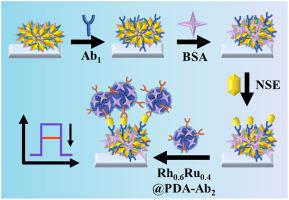Analytica Chimica Acta ( IF 6.2 ) Pub Date : 2023-03-11 , DOI: 10.1016/j.aca.2023.341085 Dawei Fan 1 , Jing Luo 1 , Zhengxing Gong 1 , Huan Wang 1 , Hongmin Ma 1 , Dan Wu 1 , Qin Wei 2 , Huangxian Ju 3

|
In this paper, a novel photoelectrochemical (PEC) immunosensor based on ZnO/CdSe semiconductor composite material was constructed to detect neuron-specific enolase (NSE) in a super-sensitive and quantitative way. The antifouling interface composed of polyacrylic acid (PAA) and polyethylene glycol (PEG) can prevent non-specific proteins from adhering to the electrode surface. As an electron donor, ascorbic acid (AA) can increase the photocurrent's stability and intensity by clearing away photogenerated holes. Because of the specific recognition between antigen and antibody, the quantitative detection of NSE can be achieved. The PEC antifouling immunosensor based on ZnO/CdSe has a wide linear range (0.10 pg mL−1–100 ng mL−1) and a low detection limit (34 fg mL−1), which has potential application in the clinical diagnosis of small cell lung cancer.
中文翻译:

基于 ZnO/CdSe 的聚丙烯酸/聚乙二醇杂化防污界面用于 NSE 的光电化学免疫传感
在本文中,构建了一种基于 ZnO/CdSe 半导体复合材料的新型光电化学 (PEC) 免疫传感器,以超灵敏和定量的方式检测神经元特异性烯醇化酶 (NSE)。由聚丙烯酸(PAA)和聚乙二醇(PEG)组成的防污界面可以防止非特异性蛋白质粘附在电极表面。作为电子供体,抗坏血酸 (AA) 可以通过清除光生空穴来提高光电流的稳定性和强度。由于抗原和抗体之间的特异性识别,可以实现NSE的定量检测。基于 ZnO/CdSe 的 PEC 防污免疫传感器具有宽线性范围 (0.10 pg mL -1 –100 ng mL -1 ) 和低检测限 (34 fg mL -1),在小细胞肺癌的临床诊断中具有潜在的应用价值。


























 京公网安备 11010802027423号
京公网安备 11010802027423号